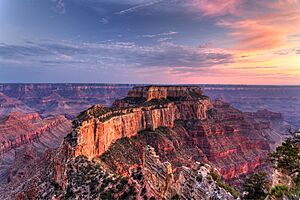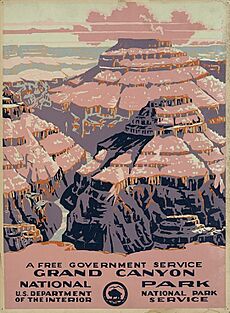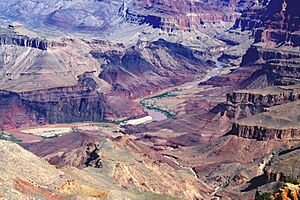Grand Canyon National Park facts for kids
Quick facts for kids Grand Canyon National Park |
|
|---|---|
|
IUCN Category II (National Park)
|
|

Grand Canyon from the South Rim at dawn
|
|
| Location | Coconino and Mohave counties, Arizona, United States |
| Nearest city | Fredonia, Arizona (North Rim) Tusayan, Arizona (South Rim) |
| Area | 1,217,262 acres (4,926.08 km2) |
| Established | January 11, 1908 as a national monument February 26, 1919 as a national park |
| Visitors | 4,919,163 (in 2024) |
| Governing body | National Park Service |
| UNESCO World Heritage Site | |
| Criteria | Natural: vii, viii, ix, x |
| Inscription | 1979 (3rd Session) |
Grand Canyon National Park is a famous national park in northwestern Arizona, United States. It is the 15th place to be named a national park in the country. The park's main feature is the amazing Grand Canyon, a huge gorge carved by the Colorado River. Many people consider it one of the Wonders of the World.
This park covers a massive area of about 1,217,262 acres (4,926 square kilometers) in Coconino and Mohave counties. In 2024, over 4.9 million people visited the Grand Canyon. In 1979, UNESCO recognized the Grand Canyon as a World Heritage Site. The park celebrated its 100th birthday on February 26, 2019.
Contents
Exploring the Park's History
The Grand Canyon became very popular in the 1880s. This happened after railroads were built, making it easier for people to visit. Early pioneers also helped create places for tourists to stay and explore.
How the Park Was Created
In 1903, President Theodore Roosevelt visited the Grand Canyon. He was deeply impressed by its beauty. He famously said that the Grand Canyon filled him with awe. He believed it was beyond comparison and description. He wanted this natural wonder to stay just as it was. He urged people to protect its grandeur for future generations.
Even with President Roosevelt's strong support, the Grand Canyon did not become a national park right away. The first idea to make it a national park came in 1882. Senator Benjamin Harrison suggested it, hoping it would be the third national park. However, his efforts were not successful at first.
Later, in 1893, President Harrison created the Grand Canyon Forest Reserve. President Theodore Roosevelt then made it the Grand Canyon Game Preserve in 1906. He also declared it a National Monument in 1908. Finally, after more attempts, President Woodrow Wilson signed the Grand Canyon National Park Act on February 26, 1919. This officially made it a national park. The National Park Service, which started in 1916, took over managing the park.
Important Milestones
Creating the Grand Canyon National Park was a big win for the conservation movement. Being a national park helped protect it from plans to build dams on the Colorado River inside its borders.
In 1975, the park grew even larger. Two other national monuments, Grand Canyon National Monument (to the west) and Marble Canyon National Monument (to the northeast), became part of the Grand Canyon National Park. In 1979, UNESCO named the park a World Heritage Site.
In 1987, a law was passed about airplane noise. It recognized that aircraft flying over the park were disturbing its natural quiet. This law aimed to address concerns about noise and safety for park visitors.
In 2010, the Grand Canyon National Park was honored with its own coin. This coin was part of the America the Beautiful Quarters program. On February 26, 2019, the park celebrated its 100th anniversary.
Recently, on July 9, 2025, a fire called the Dragon Bravo Fire caused damage on the North Rim. Several buildings, including the historic Grand Canyon Lodge, were destroyed. Firefighters worked for over a week to control the blaze.
Discovering the Grand Canyon's Geography
The Grand Canyon is famous for its incredible size and depth. It also shows many colorful layers of rock. These rocks tell a story of Earth's history, going back to ancient times. The powerful Colorado River and its smaller streams carved out this canyon. This happened after the Colorado Plateau slowly rose up.
The park has two main public areas: the South Rim and the North Rim. The rest of the park is very wild and remote. However, some parts can be reached by pack trails or backcountry roads. The South Rim is easier to get to and attracts about 90% of all visitors.
The park's main office is in Grand Canyon Village. This village is close to the South Entrance and some of the most popular viewpoints.
The South Rim: Most Visited Area
Most people visit the South Rim of the Grand Canyon. They usually arrive by Arizona State Route 64. This road enters the park near Tusayan, Arizona. It then goes east and leaves the park through the East Entrance. Interstate 40 also helps people reach this area from the south. From the north, U.S. Route 89 connects Utah, Colorado, and the North Rim to the South Rim. About 30 miles (48 kilometers) of the South Rim can be explored by road.
Grand Canyon Village is the main hub for visitors. It has everything you might need. This includes places to stay, gas, food, souvenirs, and even a hospital. You can also find churches and access to hiking trails. Park rangers offer guided walks and talks here.
Places to Stay and See
There are several places to stay along the South Rim. Hotels like El Tovar, Bright Angel Lodge, Kachina Lodge, Thunderbird Lodge, and Maswik Lodge are all in Grand Canyon Village. Phantom Ranch is a unique place to stay at the bottom of the canyon. There is also an RV Park called Trailer Village.
The El Tovar Hotel was built in 1905. It was a luxury hotel for the Atchison, Topeka, and Santa Fe Railway. Its design mixes Swiss chalet style with local materials. This gives it a rustic look, typical of early national park buildings.
Bright Angel Lodge was built in 1935 using logs and stone. Inside, there is a small museum. It honors Fred Harvey, who helped make the Grand Canyon famous. The History Room has a stone fireplace. Its layers show the same rock sequence found in the canyon.
Other interesting buildings include:
- Buckey O'Neill Cabin: Built in the 1890s, this is the oldest standing structure on the South Rim. It is now a guest house.
- Kolb Studio: Built in 1904 by brothers Ellsworth and Emery Kolb. They were photographers who took pictures of visitors on the Bright Angel Trail. Today, it is an art gallery and exhibit.
- Hopi House: Designed in 1905, it looks like ancient Hopi homes. It was a place where Hopi people sold their arts and crafts.
- Verkamp's Curios: Built in 1905, it sold arts, crafts, and souvenirs. It is now a visitor center about the history of Grand Canyon Village.
- Grand Canyon Railway Depot: Completed in 1910, this log-cabin-style train station is very rare. It is the end point for the Grand Canyon Railway from Williams, Arizona.
- Lookout Studio: Built in 1914, it offers great views of the Bright Angel Trail. You can buy photos, art, books, and rock samples here.
- Desert View Watchtower: Built in 1932, this 70-foot (21-meter) tall tower is at the far eastern end of the South Rim. It gives one of the best views of the canyon bottom and the Colorado River. It was designed to look like ancient Ancestral Puebloans watchtowers.
- Hermit's Rest: Built in 1914, this historic building was another design by Mary Colter.
The North Rim: A Higher, Quieter Side

The North Rim is located across the Grand Canyon from the South Rim. It sits on the Kaibab Plateau and Walhalla Plateau. The North Rim is much higher in elevation, over 8,000 feet (2,400 meters). Because of heavy snowfall, it closes every year from December 1 to May 15. Visitor services are also limited after October 15. Driving from the South Rim to the North Rim takes about 4.5 hours, covering over 220 miles (350 kilometers).
A popular spot on the North Rim was the historic Grand Canyon Lodge. However, the main building of the lodge was destroyed by the Dragon Bravo Fire on July 9, 2025. It had also been destroyed by fire once before, in 1932.
Grand Canyon Weather: What to Expect
The Grand Canyon has different types of weather depending on where you are. The rim areas can be cold and semi-arid, meaning dry with some cold periods. Deeper in the canyon, it can be warmer.
Summers on the rims are generally warm, with average high temperatures in July and August around 82-85°F (28-29°C). Winters are cold, with average high temperatures in January and December around 36-44°F (2-7°C). Snowfall is common on the rims during winter, especially on the higher North Rim. The canyon floor is much hotter in summer and milder in winter.
Rainfall is usually low, but there are monsoon seasons in summer. During these times, you might see thunderstorms. Always check the weather forecast before visiting, as conditions can change quickly.
Fun Activities at the Grand Canyon
North Rim Adventures
The North Rim has fewer roads, but it offers amazing viewpoints. These include Point Imperial, Roosevelt Point, and Cape Royal. You can also take mule rides deep into the canyon.
Many visitors enjoy hiking on the North Rim. Popular trails include the Widforss Trail, Uncle Jim's Trail, and the Transept Trail. The North Kaibab Trail goes all the way down to the Colorado River. From there, you can connect to trails that lead up to the South Rim.
The Toroweap Overlook is in the western part of the North Rim. It offers a dramatic view of the canyon. You reach it by driving on unpaved roads from Route 389.
South Rim Explorations
The South Rim has many activities for visitors. You can take a driving tour along the rim, which is about 35 miles (56 kilometers) long. One part, the western drive to Hermit's Point, is 8 miles (13 kilometers) long. It has several viewpoints like Mohave Point and Hopi Point. From March to December, you must use a free shuttle bus to reach Hermit's Rest. The eastern part to Desert View is 25 miles (40 kilometers) long and is open to private cars all year.
Walking tours are also popular, especially the Rim Trail. This trail runs west from the Pipe Creek viewpoint. About 8 miles (13 kilometers) are paved, followed by 7 miles (11 kilometers) unpaved to Hermit's Rest. You can start hiking almost anywhere on this trail. A shuttle can bring you back to your starting point. Mather Point is a great place to begin, as it's often the first view visitors see.
You can also take scenic flights over the canyon. These are offered by helicopters and small airplanes from nearby cities like Las Vegas and Phoenix. Due to safety rules, these flights no longer fly too close to the canyon rim within the national park.
Helping the Grand Canyon: Grand Canyon Conservancy
The Grand Canyon Conservancy (formerly Grand Canyon Association) is a special partner of the National Park Service. It is a nonprofit organization. It raises money to help Grand Canyon National Park. They do this by running gift shops and visitor centers in the park. They also offer educational programs about the area's nature and history.
Their goals include:
- Creating cultural sites that celebrate different Native American tribes.
- Protecting the park's dark night skies for stargazing.
- Supporting new discoveries and explorations within the park.
- Building and maintaining hiking trails.
See also
 In Spanish: Parque nacional del Gran Cañón para niños
In Spanish: Parque nacional del Gran Cañón para niños
- List of trails in Grand Canyon National Park
- List of national parks of the United States








